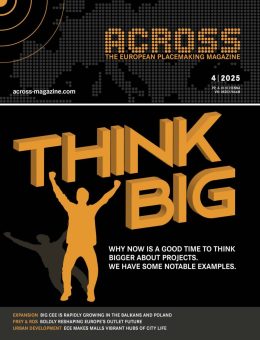Retail real estate is undergoing a profound transformation. The old anchor-and-inline leasing model is giving way to experience-led destinations—places where people don’t just shop, but stay, play, and share. One of the fastest-growing drivers of this shift is competitive socializing, a sector that has rapidly evolved from niche nightlife concepts into mainstream placemaking anchors.
Whether it’s Swingers Crazy Golf, Flight Club’s reimagined darts, F1 Arcade racing simulators, or Lane7’s mash-up of bowling, arcade games, and karaoke, these venues combine social competition, immersive design, and food & beverage to create all-day, all-age appeal.
The Decline of the Mega-Multiplex Era as a turnaround event
For decades, 15+ screen multiplex cinemas were the go-to entertainment anchor for malls. Today, that era is fading. The reasons are structural and global:
- Hollywood’s Shrinking Blockbuster Pipeline
Studios are producing fewer big-budget films capable of sustaining multiple large auditoriums year-round. - Streaming’s Dominance
Platforms like Netflix, Disney+, Amazon Prime, and Apple TV+ have cemented themselves in consumer habits. They’re not a passing trend – they’re an entrenched cultural shift. Many films now skip theatrical release entirely. - Space vs. Revenue Inefficiency
In an environment where every square metre of mall real estate must justify itself, mega-multiplexes often occupy massive footprints without delivering proportional revenue or spillover benefits to other tenants.
While some regions may trail this trend—especially where cinema culture remains deeply embedded—the structural forces behind it are universal. In time, they will or already affect global markets.
Why competitive socializing works for Malls and Mixed-Use Projects
As consumer behavior shifts from transaction-driven visits to experience-seeking journeys, competitive socializing answers several key challenges facing physical retail:
1. Driving Footfall in a Digital Age
When online shopping erodes the need for a physical trip, compelling experiences become the draw.
2. Increasing Dwell Time & Cross-Spend
Game-goers often pair their visit with dinner, drinks, and shopping.
3. Multi-Generational & Inclusive Appeal
These venues speak to millennials, Gen Z, families, and corporate groups alike.
4. Evening & Off-Peak Activation
Competitive socializing thrives during hours when traditional retail is dark.
The Experience Economy as a Growth Driver
Millennials and Gen Z are driving the “experience over possessions” shift. As they reach stronger spending power, they’re willing to pay for memorable, shareable nights out. Lane7’s retro arcade bowling, Flight Club’s high-tech darts, or Swingers’ mini-golf paired with gourmet street food perfectly capture this spending mindset.
These concepts also thrive on repeat visitation. Unlike one-off events, competitive socializing venues rotate themes, introduce seasonal challenges, and integrate digital leaderboards—keeping guests coming back.
Opportunities for Developers & Owners
For mall and mixed-use developers, competitive socializing can:
- Anchor a Destination in place of traditional entertainment tenants.
- Boost Surrounding Tenant Sales via cross-visitation.
- Reposition Upper Floors or Underused Zones into leisure hubs.
- Create a Local Identity as a place for play, not just purchase.
Risks & Considerations
- High CapEx for immersive buildouts.
- Market Saturation if similar venues cluster too closely.
- Operational Demands blending hospitality, events, and tech.
- Economic Sensitivity in downturns.
The Evolving Role of the Leasing Manager – From Rent Collector to Cultural Curator
In this new environment, leasing managers are transitioning from space sellers to destination programmers. The best now assess:
- Cultural & Brand Fit for the destination.
- Synergy Across Tenants to maximise overall spend.
- Longevity & Innovation of the concept.
- Impact Beyond Rent—from footfall to placemaking value.
This mindset shift acknowledges that a tenant’s value is no longer measured solely in rent per square metre, but in their ability to create a dynamic ecosystem that attracts and retains visitors.
Looking Ahead – Hybrid Entertainment Anchors
Expect the next generation of leisure anchors to merge competitive socializing with immersive technology, experiential dining, wellness, and esports. Flexible infrastructure will be essential—allowing quick pivots as trends evolve.
Conclusion
Competitive socializing is not just a hospitality trend – it’s a placemaking tool. For malls and mixed-use developments, it can transform underused retail space into vibrant, multi-generational, high-spend destinations. Done right, it strengthens the tenant mix, extends dwell time, and positions the property as a social hub, not just a shopping stop.

Will Odwarka
Will Odwarka is the Founder and CEO of Dubai-based firm Heartatwork Hospitality Consulting since 2019, and a member of the ACROSS Advisory Board. Born and raised in Vienna, Austria, he has 30+ years of experience leading international strategic growth and development, Franchise and partner management, and F&B operations. He successfully opened over 1000+ outlets in over 40 countries for renowned global players such as McDonald’s, Starbucks, Burger King, Costa, and Wendy’s and smaller players like Creamscafe and Coffeeshopcompany. He strongly focuses on international market entry for F&B players, brand and investor scouting, and AI in hospitality in the Middle East and Europe.







